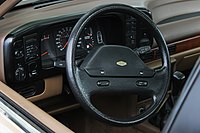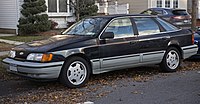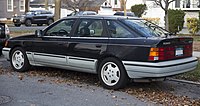
The Ford Sierra is a mid-size car or large family car manufactured and marketed by Ford Europe from 1982–1993, designed by Uwe Bahnsen, Robert Lutz and Patrick le Quément — and noted for its aerodynamic styling producing a drag coefficient of 0.34, a significant improvement over its predecessors.

Mercury is a defunct division of the American automobile manufacturer Ford Motor Company. Created in 1938 by Edsel Ford, Mercury served as the medium-price brand of Ford for nearly its entire existence, bridging the price gap between the Ford and Lincoln model lines. Its principal competition was General Motors' Buick and Oldsmobile divisions, and Chrysler Motors' DeSoto and Chrysler brands.

The Ford Country Squire is a series of full-size station wagons that were assembled by American automaker Ford. Positioned as the top-level station wagon of the Ford division, the Country Squire was distinguished by woodgrain bodyside trim. From 1950 through the 1991 model years, eight generations of the Country Squire were produced. Following the discontinuation of Edsel Bermuda, Mercury marketed the Mercury Colony Park as a divisional counterpart of the Country Squire, sharing bodywork and trim while the Mercury was not available with a six cylinder engine and was more expensive due to the optional equipment on the Ford that was standard on the Mercury.

Mercury Cougar is a nameplate applied to a diverse series of automobiles sold by the Mercury division of Ford from 1967 until 1997 and from 1999 through 2002 model years. While the nameplate is associated with two-door coupes, at various times during its production, the Cougar was also marketed as a convertible, four-door sedan, station wagon, and a hatchback.
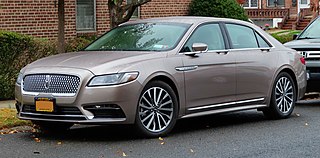
The Lincoln Continental is a series of mid-sized and full-sized luxury cars produced by Lincoln, a division of the American automaker Ford Motor Company. The model line was introduced following the construction of a personal vehicle for Edsel Ford, who commissioned a coachbuilt 1939 Lincoln-Zephyr convertible, developed as a vacation vehicle to attract potential Lincoln buyers. In what would give the model line its name, the exterior was given European "continental" styling elements, including a rear-mounted spare tire.

Merkur is a defunct automobile brand that was marketed by the Lincoln-Mercury division of Ford Motor Company from 1985 to 1989. Drawing its name from the German word for Mercury, Merkur was targeted at buyers of European executive cars in North America, selling captive imports produced by the German division of Ford of Europe.
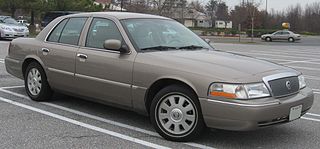
The Mercury Grand Marquis is an automobile that was sold by Mercury from 1975 to 2011. Introduced as the flagship sub-model of the Mercury Marquis, the Grand Marquis became a stand-alone model line for 1983, serving as the largest Mercury sedan. Subsequently, the model line would serve as the sedan counterpart of the Mercury Colony Park station wagon; it would later serve as the basis of the revived Mercury Marauder.
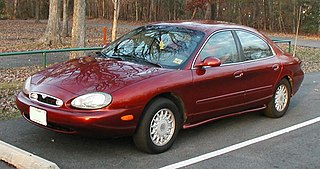
The Mercury Sable is a range of automobiles manufactured and marketed by the Mercury brand of Ford Motor Company. Introduced on December 26, 1985 as the replacement for the Mercury Marquis, the Sable marked the transition of the mid-size Mercury product range to front-wheel drive.
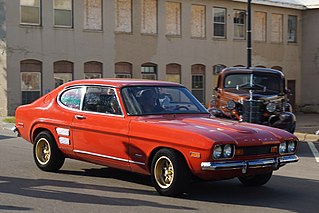
Capri is a nameplate marketed by the Lincoln-Mercury division of Ford Motor Company on three distinct series of automobiles between 1970 and 1994.

The Ford LTD is a range of automobiles manufactured by Ford Motor Company for the 1965 to 1986 model years. Introduced as the highest trim level of the full-size Ford model range, then the Galaxie, the LTD offered options and features that had previously been reserved for more luxurious Lincoln and Mercury models. The largest vehicle produced by Ford in North America for most of its production, the LTD was joined by the intermediate Ford LTD II from 1977 to 1979; the LTD II served as the replacement for the Torino/Gran Torino range. At various times throughout its production, the LTD range included two- and four-door pillared and hardtop sedans, a two-door convertible, and the Country Squire five-door woodgrain station wagon.
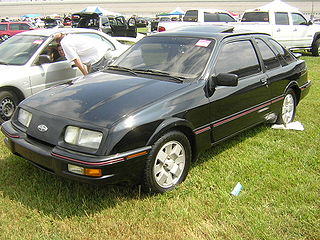
The Merkur XR4Ti is a performance-oriented 3-door hatchback sold in North America from 1985 to 1989. A product of the Ford Motor Company, the car was a version of the European Ford Sierra adapted to U.S. regulations. The XR4Ti project was championed by Ford vice president Bob Lutz.

The Mercury Turnpike Cruiser is a series of automobiles that were produced by the Mercury division of Ford for the 1957 and 1958 model years. Named to commemorate the creation of the Interstate Highway System, the Turnpike Cruiser was marketed as the flagship Mercury model line, slotted above the Montclair when Mercury was positioned upmarket to luxury status when Edsel was introduced in 1958.

The Mercury Montclair is a series of full-size sedans that were manufactured and marketed by the Mercury division of Ford. The nameplate was used by the division twice, from the 1955 to the 1960 model years and from the 1964 to the 1968 model years. While not offered as a station wagon, the Montclair was offered as two-door and four-door hardtops, four-door pillared sedan, and a two-door convertible.
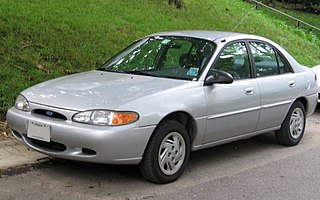
The North American version of the Ford Escort is a range of cars that was sold by Ford from the 1981 to 2003 model years. The direct successor of the Ford Pinto, the Escort also largely overtook the role of the European-imported Ford Fiesta as the smallest vehicle in the Ford model line in North America. Produced across three generations, the first generation was a subcompact; the latter two generations were compact cars. Becoming highly successful in the marketplace, the Escort became the best-selling car in the United States after 1982, a position it would hold for much of the 1980s.
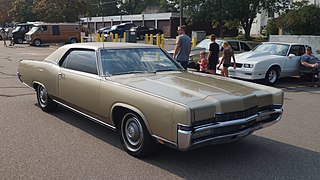
The Mercury Marquis is a model line of automobiles that was marketed by Mercury from 1967 to 1986. Deriving its name from a French nobility title, the Marquis was introduced as the divisional counterpart of the Ford LTD; four generations of the two model lines were paired through rebranding. Initially slotted as the flagship Mercury full-size range, the Marquis would serve as the basis for the later Mercury Grand Marquis.
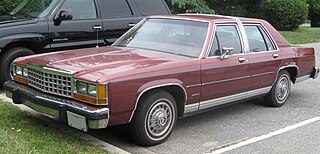
The Ford LTD Crown Victoria is a line of full-size cars that was manufactured and marketed by Ford from the 1980 to 1991 model years. Deriving its name from the Ford Fairlane coupe of 1955–1956, the LTD Crown Victoria served as the flagship of the Ford LTD model range in North America. Serving as the Ford counterpart of the Mercury Grand Marquis, the model line was offered as a two-door and a four-door sedan and a five-door station wagon.
The Ford C3 transmission and its descendants are a family of light-duty longitudinal automatic transmissions built by the Ford Motor Company.
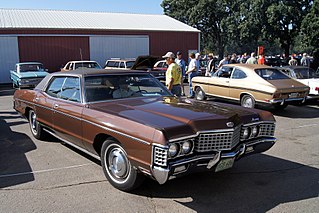
The Mercury Monterey is a series of full-size cars that were manufactured and marketed by the Mercury division of Ford from 1952 to 1974. Deriving its name from Monterey Bay, the Mercury Monterey served as the upscale version of the Mercury Custom which replaced the Mercury Eight, the debut model line of the Mercury division. During its production, the Monterey would be offered in multiple body styles, ranging from coupes, convertibles, sedans, hardtops, and station wagons.

The North American version of the Ford Granada is a range of sedans that was manufactured and marketed by Ford over two generations (1975–1982). Developed as the original successor for the Ford Maverick, the Granada shares its name with Ford of Europe's flagship sedan. The model line was marketed as a luxury compact vehicle, expanding the segment in the United States.

The eighth generation of the Ford Thunderbird is a personal luxury coupe that was manufactured and marketed by Ford from the 1980 to 1982 model years. Introduced to commemorate the 25th year of the Thunderbird, the eighth generation was substantially downsized, transitioning further into the mid-size segment. For a second generation, the Thunderbird remained the Ford counterpart of the Mercury Cougar XR7; while the Cougar again served as a complete line of mid-sized cars in various body styles, the Thunderbird was offered solely as a two-door personal luxury coupe.


